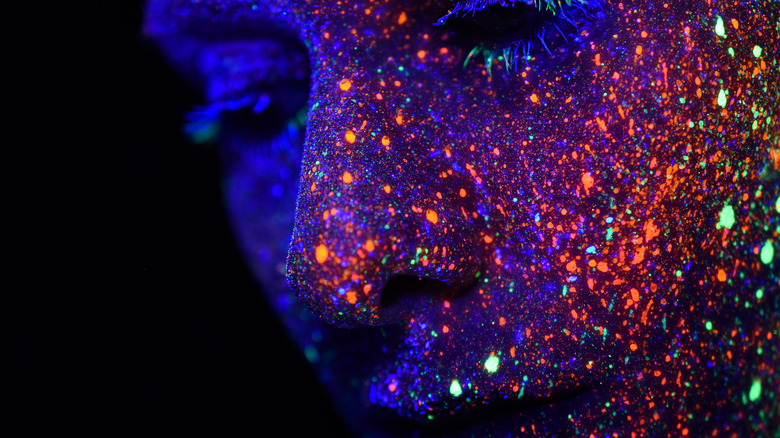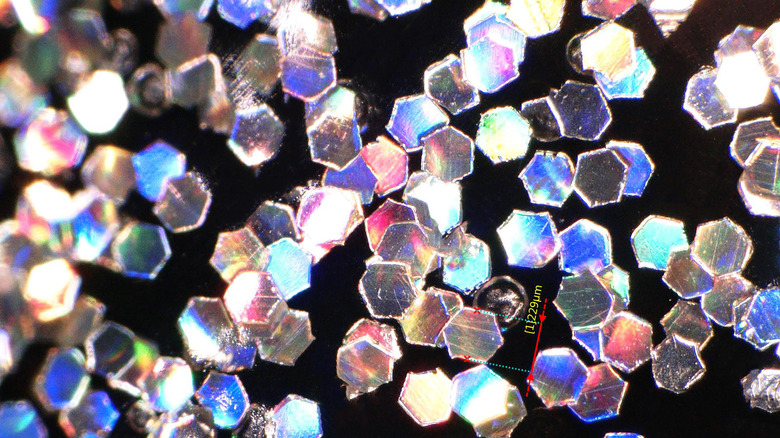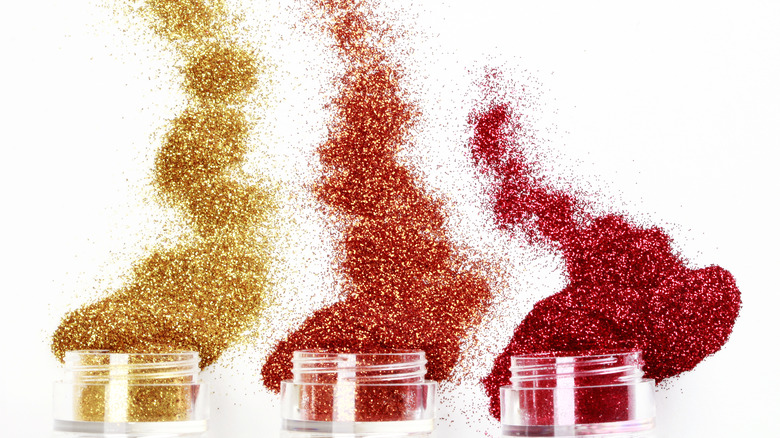Why The World's Largest Glitter Consumer Remains A Mystery
Glitter: that horribly tacky stuff that never goes away and just spreads and spreads until one day five years later after that fateful party you still find a speck under the couch. Could there be greater evidence of the human love of all things sparkly? The New York Times' deep dive into the glitter industry suggests that people are attracted to twinkling things because of an instinctual attraction to the glint of watery surfaces. If true, then a biological mechanism meant to keep us alive and drinking water now serves the interests of an industry that exchanges cash for plastic and aluminum dust that take 1,000 years to biodegrade. But who, aside from obvious choices like cosmetic companies, buys tons of glitter?
We at least know who makes most of the world's glitter. Per The New York Times, most glitter is produced at two separate glitter companies, both located in New Jersey, U.S.A. Glitterex was founded in 1963, and is "the only U.S.-based glitter manufacturer that has in-house coating capability." This allows for maximum control over the production process and responsiveness to customer needs. The other company — unnamed in the article — seems to be Meadowbrook Glitter, founded in 1934.
When interviewed by The New York Times, Glitterex employees remained weirdly hush-hush. The inside of the factory was off-limits. Items on display were not to be described. And their top client? Employees seem intent on taking the secret to their shiny, rainbow-dusted graves, and no one knows why.
[Featured image by h heyerlein via Wikimedia Commons | Cropped and scaled | CC0 1.0 ]
All that glitters
It's ironic that the makers of a ubiquitous, gleaming, attention-grabbing substance are so secretive. When asked if she could say who buys most Glitterex products, manager Lauren Dyer told The New York Times, "No, I absolutely know that I can't," continuing, "And you would never guess it. Let's just leave it at that." As for the reason behind such secrecy, Dyer said, "Because they don't want anyone to know that it's glitter." The "it's" in her statement presumably refers to the products used by Glitterex clients. And to be clear, we're not talking one, single company that scoops up most of the world's glitter, but an entire industry that wants its purchases to remain unknown.
Naturally, because secrecy breeds curiosity, folks have taken to speculating, deducing, and debating which industry buys the most glitter. Sparkling substances like toothpaste often come up in conversation, as Cracked describes. Slate suggests that glitter might be used in the creation of paper money to make it difficult to counterfeit. Paint-makers are obvious suspects, too, as are the cosmetics industry and makers of food-grade edible glitter that goes on confectionaries.
But as First and First Consulting and Collective World both claim, it's the military who buys the most glitter. How else make explosives oh so fantabulous when they go boom? If true, this would explain why Lauren Dyer said that no one would guess Glitterex's top market. Fewer things seem more opposed than eyeshadow sparkles and flesh-rending fire and shrapnel.
[Featured image by Gabriela P. via Wikimedia Commons | Cropped and scaled | CC BY 4.0]
A shining, shimmering conspiracy
There's one problem with the assertion that most of the world's glitter goes into military explosives: the claim remains unsubstantiated. In fact, the incongruity of "military" and "glitter" is exactly the type of nifty, "whoa, no way" statement sure to garner clicks and viral attention.
First and First Consulting don't offer data for such conclusions, only the opinions of people patrolling Twitter — and we all know how reliable how those are. Collective World quotes Reddit user raydoctor describing "microtaggants" like glitter included in explosives as a kind of tracing device to see where explosives materials came from. Microtaggant maker Microtrace does say that "microtaggant identification particles" include plastics, but that's it. And yes, glitter — more accurately aluminum metalized polyethylene terephthalate — is made from plastic. Meanwhile, as evidence of glitter's "largest and most recently discovered buyer," Newsbreak links a 2022 U.S. Department of Defense proposal regarding the funding of technological innovations developed by small businesses. The only problem? Amidst discussions of propellants, machine learning, and "battlespace environments," there's no mention in the 422-page report of anything resembling the stuff that people paint on their faces at Coachella.
And yet, per The U.S. Sun, late 2022 saw TikTok aflutter with conspiratorial musings about why the world is running low on glitter. While we doubt companies like Glitterex are running low on revenue streams, it's at least true to say that glitter is made from the same, dwindling, non-renewal resource that fuels vehicles and heats homes.


